The Best Sales Cadence Based on 33 Million Emails
Jenny Keohane
The key to an effective sales cadence is figuring out what works and what doesn’t. To help you refine your strategy, we dove into our database of 33 million tracked email activities over the past three years to identify the best sales cadence for your outreach campaigns.
Yesware data analyst, Abigail Ezedonmwen, looked at eight high-growth technology companies to see what patterns yield results in their email campaigns. These companies all achieve over $100 million in revenue with full-cycle B2B sales teams.
Below, we look at what frequency, channels, and timing yield the highest connect/reply rates. We also break down this data a step further to provide insights that’ll help you replicate similar workflows.
Here’s what we’ll cover:
- What Is a Sales Cadence?
- Advantages of a Sales Cadence
- How to Build an Effective Sales Cadence (Based on Data)
- The Optimal First Six Touches of Your Sales Cadence
- Sales Cadence Frequency Data
- Best Sales Cadence Example
What Is a Sales Cadence?
A sales cadence is a sequence of activities (called touchpoints) that sales professionals follow to engage with prospects, build relationships, and ultimately close deals.
Sales cadences comprise all the attempts at contacting prospects through various channels. The channels most commonly consist of phone, email, and social media.
The cadence begins at the first point of contact until the prospect is either converted to a sales opportunity or leaves the cadence (and is then nurtured).
It’s highly encouraged to use multiple channels to connect with prospects to ensure connection and engagement.
These touches depend on the sales rep, company, and business strategy. Many reps continually adjust their sales cadence to test different strategies and techniques.
Although every team has their own unique sales cadences, the success rates of frequency, timing, and methods of outreach can be consistent.
Advantages of a Sales Cadence
There are many advantages of having an effective sales cadence in place.
Let’s look at a few.
- More Structure: Sales cadences provide a systematic framework that helps ensure sales reps are reaching out to prospects with the right channel at the right time.
- Easy Tracking: Sales cadences make it easy to track and refine your outreach strategy based on what’s working and what’s not.
- Shorter Sales Cycles: Following up with prospects regularly helps to speed up communication and shorten the sales cycle.
- Visibility: Sales cadences give reps full visibility into where prospects are in the sales funnel so nothing slips through the cracks.
- Consistency: With a strong sales cadence in place, you maintain a consistent sales process.
How to Build an Effective Sales Cadence (Based on Data)
Building the messaging for your sales cadence will depend on your target buyer persona and ICP. But when it comes to the type of channel, frequency, and timing, we conducted this study to help identify what yields the most replies.
Before we dive into the data, to clarify, social interactions such as LinkedIn InMail cannot be tracked and measured in this study. We can only track phone and email outreach in our database.
LinkedIn interactions are highly effective and should be tested and measured on your own terms to determine how this channel resonates with your audience.
Another important caveat to note is that we only analyzed six touches from each campaign.
Many studies indicate that eight to nine touch campaigns are optimal. And the average length of the campaigns in this study falls right under eight touches, 7.56 to be exact. But sales cadence lengths vary. For this study, we zone in and focus on the first six activities since these are the most important for capturing your prospect’s attention.
Now let’s look at the data.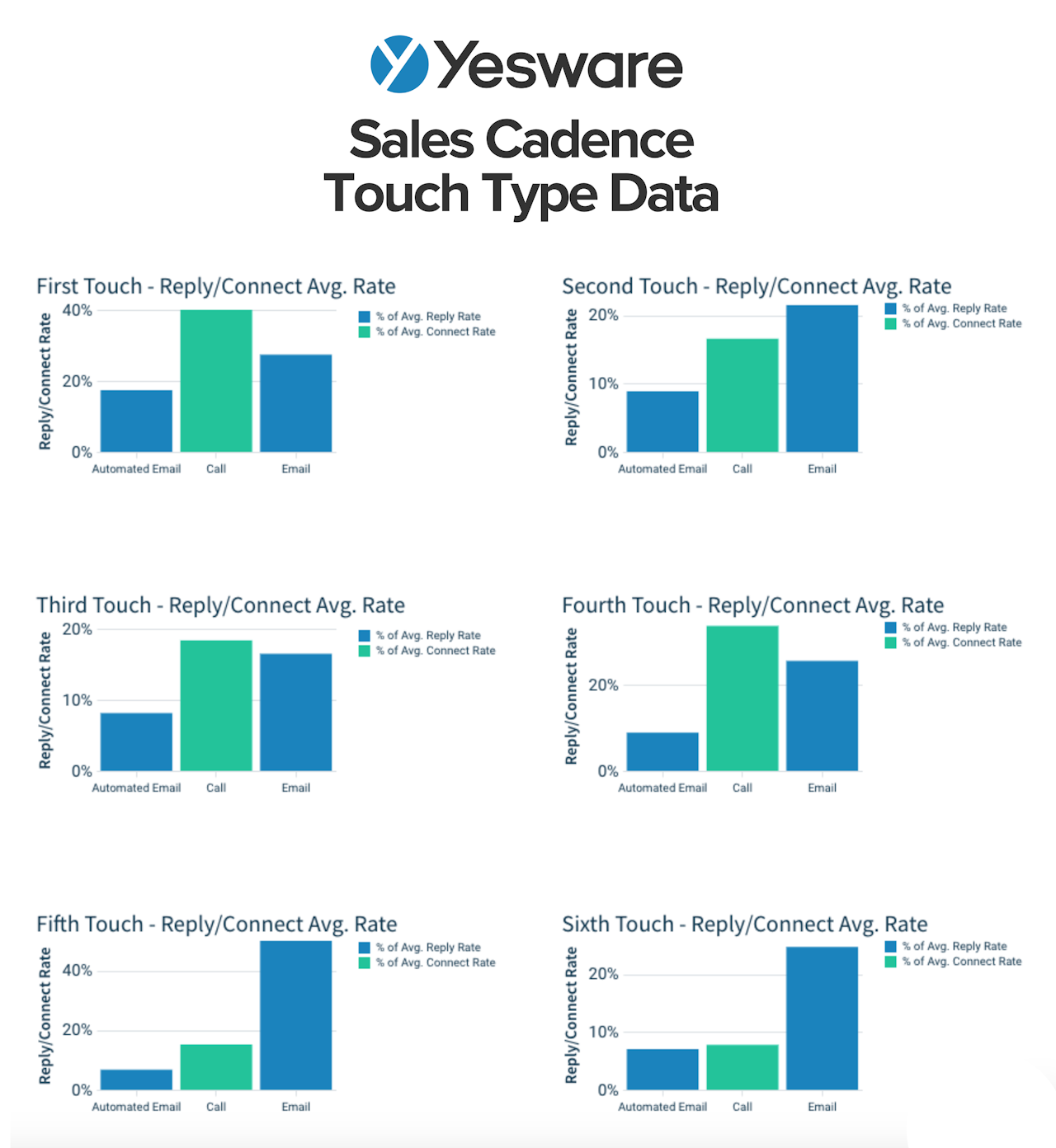
After analyzing this data, we researched and talked to sales professionals about their sales cadences to make sense of the findings. We discuss these throughout the article to help you further understand the outcomes.
Let’s break this down.
The Optimal First Six Touches of Your Sales Cadence
First Touch: Call Your Prospect
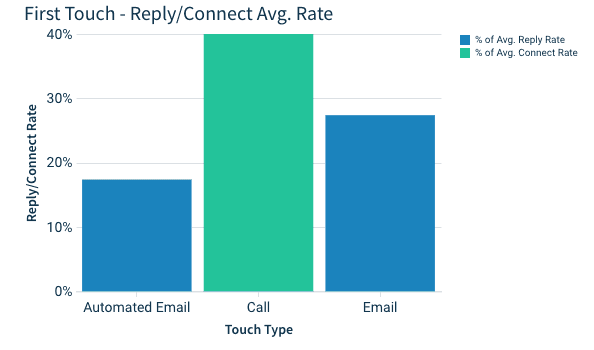 This data finding is clear evidence that cold calling is not dead.
This data finding is clear evidence that cold calling is not dead.
When talking to sales professionals about their sales cadence, there is a common theme of speed. Calling is the fastest way to connect with recipients. You can cover much more ground in a conversation than going back and forth over email, which shortens the sales cycle.
These top domains call for their first touch because talking to prospects is more personable and conversational. It helps the rest of your sales cadence with both speed and building rapport.
To ensure the best outcomes, always call with a clear reason such as an observation made about their business that you want to discuss further.
Tip: Grab a sales call script here.
Second Touch: Send a Follow-up Email
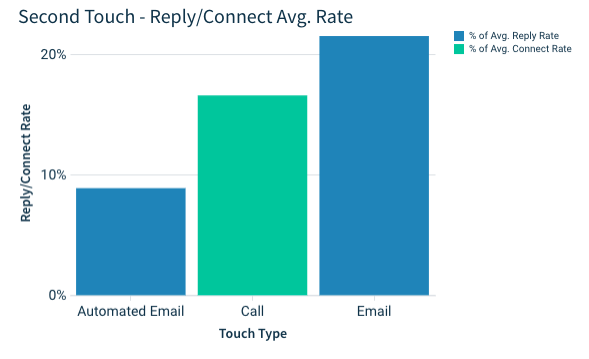 It isn’t surprising that the data indicates email is the most effective second touch. That’s because after you call, you always want to send a follow-up email to explain your reasoning for calling.
It isn’t surprising that the data indicates email is the most effective second touch. That’s because after you call, you always want to send a follow-up email to explain your reasoning for calling.
With each follow-up, you create more opportunities for your recipient to reply, and your first follow-up is the most important to ensure momentum.
This finding also tells us that manual emails are more effective than automated emails, which draws light on how important personalization is these days. Buyers today prefer a more personal approach. Always cater your message to the recipient, their company, and their specific needs.
Third Touch: Call and Leave a Voicemail
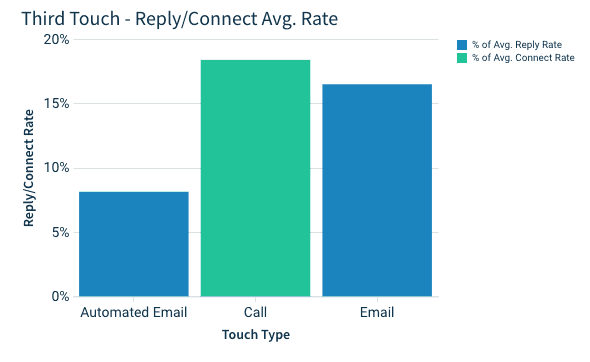 The most effective channel for your third touch is calling, but not by much. Call and email touch types are very close here — 18% and 16% respectively.
The most effective channel for your third touch is calling, but not by much. Call and email touch types are very close here — 18% and 16% respectively.
This gives you more flexibility in your sales cadence to test which channel works best for you and your specific audience.
Set an email reminder to follow up on your second touch. If the recipient doesn’t answer, leave a voicemail. Either way, you’re leaving the recipient with information and your goal is to ensure your message resonates.
When talking to sales professionals, the common reasons as to why calling is slightly higher here is because 1) it’s often the fastest way to do business and 2) when prospects don’t answer the first call and follow-up, they’re likely to try again to attempt to catch them at a better time.
Tip: Grab sales voicemail scripts here.
Fourth Touch: Call Again
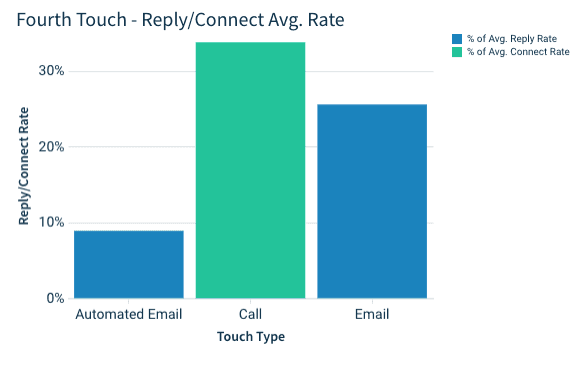 For the fourth touch, calling is much more evident here.
For the fourth touch, calling is much more evident here.
This tends to be the point where salespeople differ their outreach channels, depending on their specific sales cadence. Try changing up your message here and if you haven’t tried LinkedIn yet, this could be a great chance to utilize it.
Another common theme discussed with sales reps is that this touch may indicate one last try at calling the prospect before the fifth and sixth touch where reps focus on sharing as much value as possible in their final email outreach.
Once you get to the fourth touch, if you’re not having luck yet, try to change something up in your messaging. See if a new strategy clicks.
Fifth Touch: Send Another Follow-up Email
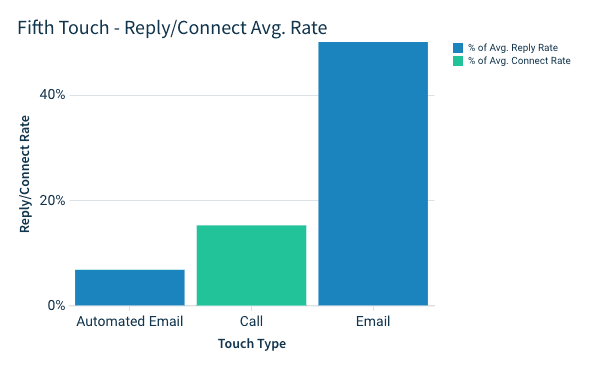 For the final two touches of this study, it seems email takes the prize by a sufficient amount.
For the final two touches of this study, it seems email takes the prize by a sufficient amount.
This is where salespeople focus on value related to their business. You’re trying to demonstrate a unique position/insight that will benefit the prospect.
Sending case studies and other sales collateral here will help to demonstrate value and show prospects what similar companies have achieved with your solution.
If you haven’t been successful in demonstrating this throughout your sales cadence, try a new technique. Re-demonstrate the value you can provide.
Sixth Touch: The Breakup Email
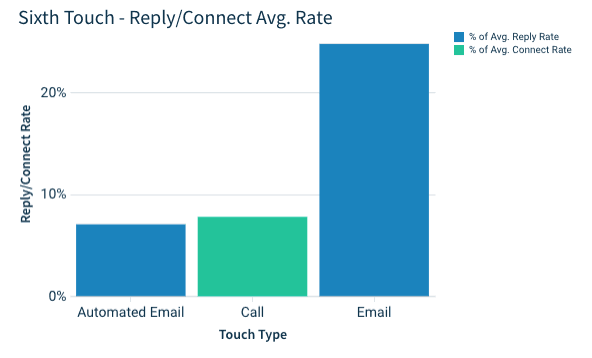 By the end of your sales cadence, it’s important to send your sales breakup email. Your breakup email is where you make your final case, provide a lasting piece of value, and ensure they know where to find you if anything changes.
By the end of your sales cadence, it’s important to send your sales breakup email. Your breakup email is where you make your final case, provide a lasting piece of value, and ensure they know where to find you if anything changes.
In this final email, sales reps often discuss the importance of shadowing future events, such as a lasting statement that will instill value. This can be a phrase that tells the recipient you want to support them to be successful in the future and extend any offers.
Tip: Grab more data-backed findings on outreach strategies below.
 Sales Engagement Data Trends from 3+ Million Sales ActivitiesLooking at millions of tracked email activity over the past few years, this ebook is filled with our top studies and findings to help sales teams accelerate results.
Sales Engagement Data Trends from 3+ Million Sales ActivitiesLooking at millions of tracked email activity over the past few years, this ebook is filled with our top studies and findings to help sales teams accelerate results.
Sales Cadence Frequency Data
Next, we analyzed some of the top-performing campaigns and studied their behavior. The results of this analysis show the ideal timing between each touch based on reply/connect rates.
This sales cadence lasts about two weeks long. The optimal sales cadence lasts around two to four weeks.
You should wait at least a day between outreach attempts, but no more than five days.
Let’s look at the data.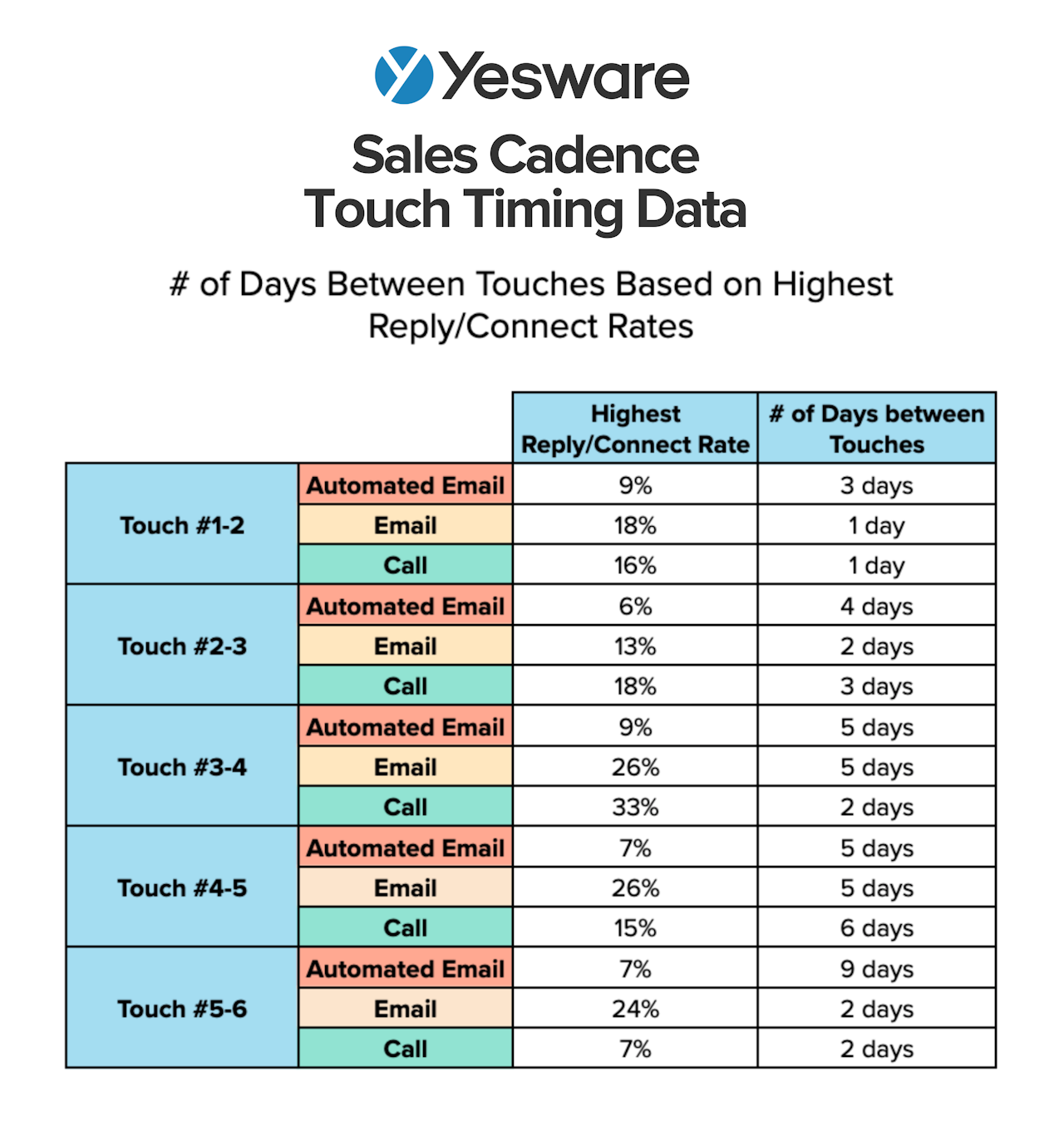 In this study, we focus on reply rates over open rates, because that’s by far more important.
In this study, we focus on reply rates over open rates, because that’s by far more important.
This study’s findings show the ideal number of days between touches for each channel. For creating the best sales cadence, we’ll focus on the most effective.
This is what the chart above tells us:
Second touch: Wait one day and email.
Third touch: Wait three days and call.
Fourth touch: Wait two days and call.
Fifth touch: Wait five days and email.
Sixth touch: Wait two days and email.
Let’s Pull It All Together: Best Sales Cadence Example
Finally, pulling all the data and findings together, 33 million tracked email activity indicates that the below sales cadence is the most effective based on connect/reply rates.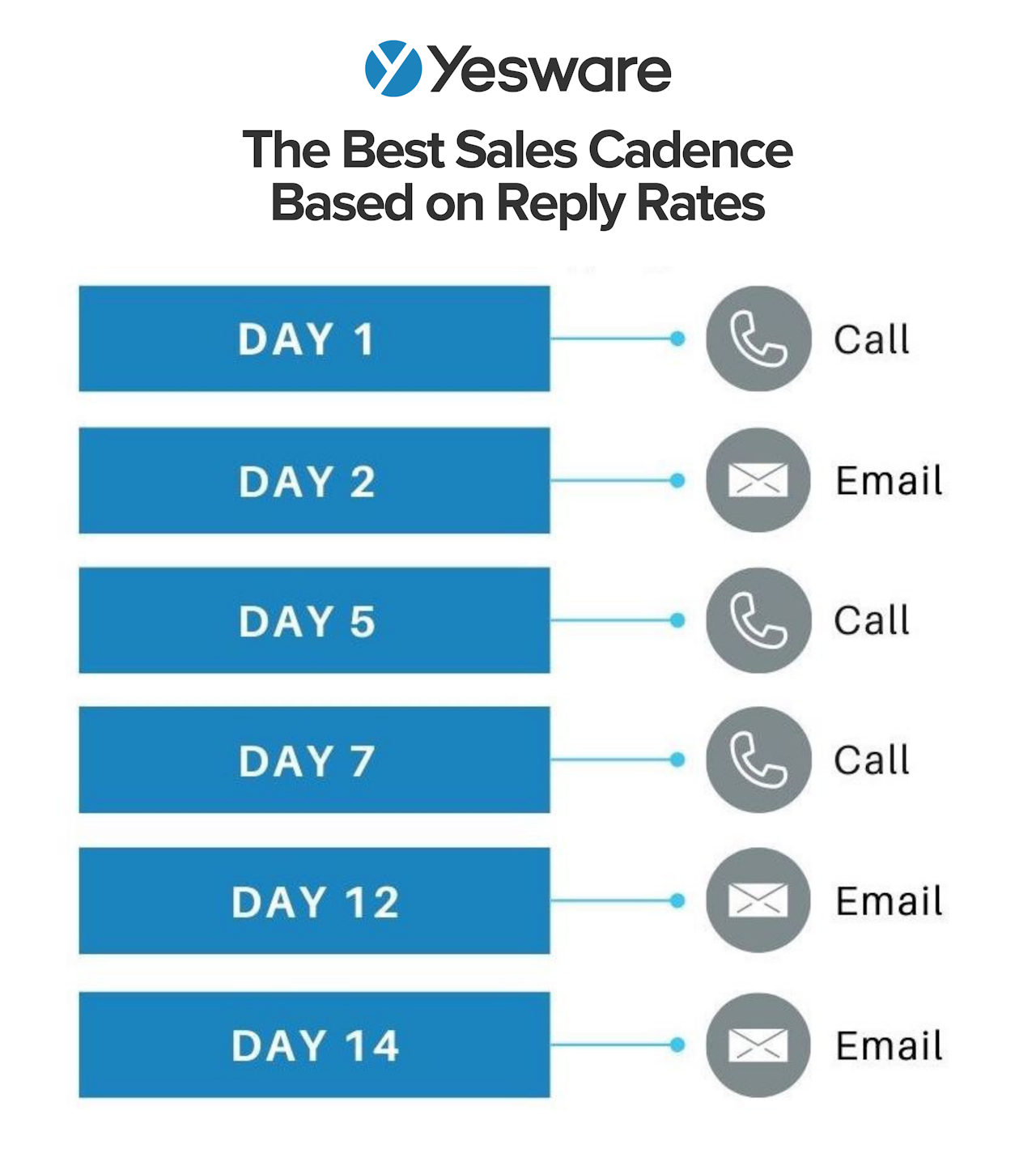
Conclusion
This data is meant to inspire you to try new workflows and see what resonates with your audience.
When it comes down to it, what’s most important is the messaging of your outreach. You can master the perfect sales cadence but still not succeed if the messaging doesn’t engage and resonate with your recipients.
Take this data, try out similar techniques and insights discussed, track and measure, and then see the results for yourself.
Remember, continue testing your sales campaigns so that you can improve your sales cadence based on how buyers are engaging. With the rapidly changing sales space, it’s important to stay on top of buyer behaviors and up-to-date strategies.
Bonus: Hungry for More Data? Watch Our Webinar for More Sales Best Practices
Get sales tips and strategies delivered straight to your inbox.
Yesware will help you generate more sales right from your inbox. Try our Outlook add-on or Gmail Chrome extension for free, forever!
Related Articles
Jenny Keohane
Jenny Keohane
Jenny Keohane
Sales, deal management, and communication tips for your inbox

